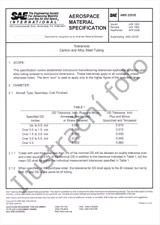Potřebujeme váš souhlas k využití jednotlivých dat, aby se vám mimo jiné mohly ukazovat informace týkající se vašich zájmů. Souhlas udělíte kliknutím na tlačítko „OK“.

SAE AIR5715
Procedure for the Calculation of Aircraft Emissions
Přeložit název
NORMA vydána dne 1.7.2009
Informace o normě:
Označení normy: SAE AIR5715
Datum vydání normy: 1.7.2009
Kód zboží: NS-653994
Země: Americká technická norma
Kategorie: Technické normy SAE
Anotace textu normy SAE AIR5715 :
This AIR describes procedures for calculating emissions resulting from the main engines of commercial jet and turboprop aircraft through all modes of operation for all segments of a flight. Piston engine aircraft emissions are not included in this AIR. Some information about piston engine aircraft emissions can be found in FOCA 2007. The principal purpose of the procedures is to assist model developers in calculating aircraft emissions in a consistent and accurate manner that can be used to address various environmental assessments including those related to policy decisions and regulatory requirements.
The pollutants considered in this document are:
Nitrogen Oxides (NOx)
Carbon Monoxide (CO)
Total unburned Hydrocarbons (THC)
Carbon Dioxide (CO2)
Water (H2O)
Sulfur Oxides (SOx)
Volatile Organic Compounds (VOC)
Methane (CH4)
Non-Methane Hydrocarbons (NMHC)
Non-Methane Volatile Organic Compounds (NMVOC)
Nitrous Oxide (N2O)
Particulate Matter (PM2.5 and PM10)
As indicated above, hazardous air pollutants (HAPs) are not individually accounted for; many of these are simply included as part of THC. Also, trace metals are not included other than those that may already be accounted for as part of PM emissions. Since the scope is limited to aircraft engine emissions only, emissions from Ground Service Equipment (GSE), roadway vehicles, power plants, training fires, etc., are not included within this document. Athough Auxilliary Power Units (APU), brakes, and tires are also part of the aircraft, their emissions (e.g., tire wear) are not within the scope of this document.
The methods are based on aircraft performance and emissions modeling. This means that only the pollutants exiting the exhaust of an engine are considered. Any atmospheric effects including those that occur in the near-field (e.g., exhaust plume) and the subsequent atmospheric dispersion are not modeled. The exception to this is in the computation of PM emissions.
In meeting the needs of modelers who may have varying fidelity requirements for both emissions and aircraft performance modeling, this document does not try to promote a single database and methodology. Therefore, several methods have been included in this document as indicated below with the emissions methods categorized by pollutants:
Emissions Modeling Methods
?
NOx, CO, and THC
?
P3T3
?
Boeing Fuel Flow Method 2 (BFFM2)
?
Deutsche Forschungsanstalt fur Luft- and Raumfahrt (DLR) Method
?
International Civil Aviation Organization (ICAO) Reference Method
?
CO2, H2O, and SOx
?
Fuel Composition Method (FCM)
?
VOC, NMVOC, CH4 and NMTHC
?
Derivative Factor Method (DFM)
?
N2O
?
Approximate Factor Method (AFM)
?
PM2.5 and PM10
?
First Order Approximation (FOA)
Aircraft Performance Methods
?
Aircraft performance data from flight data recorders
?
Manufacturer aircraft performance models
?
SAE AIR 1845 combined with Eurocontrol’s Base of Aircraft Data (BADA)
?
Eurocontrol’s BADA
?
Other aircraft performance models such as the Project Interactive Analysis and Optimisation (PIANO) tool
Both of these sets of emissions and aircraft performance methods are listed in the order in which they are presented in this document. And as previously indicated, the order generally denotes the level of accuracy where the first method in each section represents the most accurate method based on current understanding. The exceptions to this are:
Emissions Methods
BFFM2
DLR
Aircraft Performance
SAE 1845 + BADA
BADA
The ordering of these methods are arbitrary since they are considered comparable (e.g., BFFM2 is comparable to DLR). One other possible exception is the last listing under aircraft performance methods (“Other aircraft performance models”). The data from these other sources may be more accurate, comparable, or less accurate than the previously mentioned methods. This last category was added to include all other methods that were not based on manufacturer, SAE 1845, and BADA models.
In order to provide a better understanding of the relative condition of these methods, they have been defined into development status (i.e., “mature” or “developing”) and fidelity (i.e., “simple,” “intermediate,” or “advanced”) categories as presented in Table 1.
The “other” aircraft model category was not included in Table 1 since it is understood that it can be listed in any of the categories depending on which method/model is employed. The definitions for each of the categories are as follows:
In modeling aircraft performance and emissions, the main focus is on a single flight. This includes the complete operation and movement of the aircraft from gate-to-gate:
Main engine start-up
Ground taxi-out and delay activities
Takeoff: Runway roll
Takeoff: Initial ascent
Climbout
En route/cruise
Airborne delay activities
Approach
Landing roll
Thrust reverser
Ground taxi-in and delay activities
Engine shut-down
For modeling purposes, these modes can generally be simplified so that they are equated to one of the four LTO modes. Depending on the method, the actual modeling of the gate-to-gate movement may involve a segment-by-segment approach where results can be integrated to obtain totals by mode and flight. Currently, the AIR does not address emissions during engine start-up and shut-down activities. Also, thrust reverse operations are not directly covered in this AIR.
SUBJECT TAXONOMY: Emissions, Environmental regulations and standards, Noise
SUBFILE: Aerospace
TYPE OF DOCUMENT: Aerospace Standard



 Cookies
Cookies
